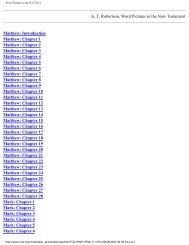Commentary on Joshua - Keil & Delitzsch - David Cox
Commentary on Joshua - Keil & Delitzsch - David Cox
Commentary on Joshua - Keil & Delitzsch - David Cox
You also want an ePaper? Increase the reach of your titles
YUMPU automatically turns print PDFs into web optimized ePapers that Google loves.
<strong>Keil</strong> and <strong>Delitzsch</strong> <str<strong>on</strong>g>Commentary</str<strong>on</strong>g> <strong>on</strong> the Old Testament<br />
<br />
to Josh 18:12, the same boundary went up by the shoulder of Jericho towards the<br />
north, i.e., al<strong>on</strong>g the northern range of mountains by Jericho, which cannot be any<br />
other than the "c<strong>on</strong>spicuous double height, or rather group of heights," in fr<strong>on</strong>t of the<br />
mountain of Quarantana, at the eastern foot of which lies the fountain of Ain es Sultan<br />
( Rob. ii. p. 284). In all probability, therefore, the boundary ran up towards the northwest,<br />
from the Sultan fountain to Ain Duk, and thence in a westerly directi<strong>on</strong> across to<br />
Abu Seba (al<strong>on</strong>g which road Robins<strong>on</strong> had a frightful desert <strong>on</strong> his right hand: Pal. ii.<br />
p. 310), and then again towards the north-west to Beitin (Bethel), according to Josh<br />
18:13, al<strong>on</strong>g the southern shoulder (or side) of Luz, i.e., Bethel.<br />
Verse 2. "And it went out from Bethel to Luz." Bethel is distinguished from Luz in<br />
this passage, because the reference is not to the town of Bethel, which was called Luz<br />
by the Canaanites (vid., Gen 28:19), but to the southern range of mountains bel<strong>on</strong>ging<br />
to Bethel, from which the boundary ran out to the town of Luz, so that this town,<br />
which stood up<strong>on</strong> the border, was allotted to the tribe of Benjamin (Josh 18:22). From<br />
this point the boundary went over "to the territory of the Arkite to Ataroth," We know<br />
nothing further about the Arkite than that <strong>David</strong>'s friend Hushai bel<strong>on</strong>ged to that<br />
family (2 Sam 15:32; 16:16; 1 Chr<strong>on</strong> 27:33). Ataroth , called Ataroth-Adar in Josh<br />
18:13, was not the present village of Atâra, an hour and a half to the south of Jiljilia (<br />
Rob. iii.<br />
p. 80), as I <strong>on</strong>ce supposed, but the ruins of Atâra , three-quarters of an hour to the<br />
south of Bireh (Beeroth, Rob.<br />
ii. p. 314), with which the expressi<strong>on</strong> "descended" in Josh 18:13 perfectly harm<strong>on</strong>izes.<br />
C<strong>on</strong>sequently the boundary was first of all drawn in a south-westerly directi<strong>on</strong> from<br />
Beitin to Bireh (Josh 18:25), and then southwards to Atârah.<br />
Verse 3. From this point "it went down westward to the territory of the Japhletites to<br />
the territory of lower Beth-hor<strong>on</strong>," or, according to Josh 18:13, "to the mountain (or<br />
range) which is <strong>on</strong> the south by lower Beth-hor<strong>on</strong>." The Japhletite is altogether<br />
unknown as the Asherite of this name cannot possibly be thought of (1 Chr<strong>on</strong> 7:32-<br />
33). Lower Beth-hor<strong>on</strong> is the present Beit-Ur Tachta , a village up<strong>on</strong> a low ridge. It is<br />
separated from Upper Beth-hor<strong>on</strong>, which lies farther east, by a deep wady (see at Josh<br />
http://207.44.232.113/~bible/comment/ot/k&d/josh/jos104.html (1 of 2) [13/08/2004 01:18:49 p.m.]
















